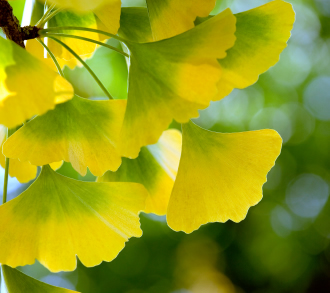Traditional Herbs of China

Ginkgo Biloba
Ajwain Seed * Aloe * Andrographis * Angelica * Arjuna * Asafoetida * Ashwagandha * Asparagus (Satavari) * Bacopa * Club Moss (Wolf's Claw) * Codonopsis (Dang Shen) * Coptis (Huang Lian) * Corydalis (Yan Hu So) * Datura * Dong Quai (Dang-gui) * Eleuthero (Wu Jia Shen Jing) * Epimedium (yin yang huo) * Fo-Ti Root (He-shou-wu) * Forsythia (Lian Qiao) * Gentian * Ginger Root (Luyang Dilaw) * Forsythia (Lian Qiao) * Ginkgo biloba * Ginseng (Ren-shen) * Goji Berries * Honeysuckle ( jin yin hua) * Jasmine * Jiaogulan * Kudzu * Licorice Root (Gan-cao) * Maitake mushroom * Motherwort * Oolong Tea * Mandarin Orange * Rehmannia root (Shu Di Huang) * Reishi Mushroom (Ling-zhi) * Rhodiola * Schisandra (wu-wei-zi) * Skullcap * Snakeroot * Solomon's Seal Tea * Turkey Rhubarb * White Peony (Bai Shao Yao)* Yarrow
With an estimated 30,000 flowering plant species, China possess a diverse and rich flora to form the basis of Traditional Chinese Medicine. At least 5,000 of those plant species are used as medicinal plants in China, and many of those are used as food. The line between medicinal food and medicinal plants is blurry in China, as it is in all herbal traditions.
History In China, traditional medicine is a integral part of the culture going back at least 5,000 years. Soon after the revolution in China, in 1949 Mao Zedong ordered that the Chinese people strive to validate the efficacy of traditional remedies. This lead to the successful integration of TCM and modern Western style medicine that could serve as a role model for us here in the West, where the two systems are at odds. In the 1970s interest in herbal medicine began to reemerge and with it many Chinese herbal remedies began appearing on health food store shelves.
The acceptance of herbal medicine in the West owes a debt to the Asian cultures. Many Chinese medicinal plants are well known, most notably Panax ginseng and Angelica sinensis (dan-gui), which have counterpart species here in North America, American ginseng, Panax quinquefolium and angelica Angelica archangelica. Indeed American gardens are a rich source of Chinese medicinal plants, day lilies, chrysanthemums and peonies to name a few, however these plants are valued here only as ornamentals.
Principles TCM is a combination of energy theories, acupuncture, and herbal prescriptions. The Chinese system distinguishes between plants used as "drugs" and "herbs". While about 500 plants are used as official drugs, there are roughly 4,500 plants used in folk medicine by the people of the countryside. Root drugs are considered most important, followed by seeds and fruits, with leaf drugs considered least important.
Properties The four properties are cold, hot, warm, and cool. The general principle of treatment is to treat heat-syndrome conditions like fever with cold-natured drugs, and patients with cold-syndrome diseases with warm drugs.
Flavors The five flavors of TCM are sour, bitter, sweet, hot, and salty. Acrid(pungent or hot) has the function of expelling cold. Sour has an astringent function. Sweet has the ability to alleviate pain. Bitter drugs help to harden and dry tissue. Salty drugs are able to soften hard lumps, such as tumors. Some herb drugs have more than one flavor, the first or primary one is used to determine its uses.
Trends of herb functions There are four trends of drug functions: lifting, lowering, floating, and sinking. Diseases are also classified by direction, for instance a cough rises from bottom to top. In TCM the practice is to use a herb that moves in the opposite direction as the condition.
Attributive Channels These channels are the particular meridian, organ or group of organs in the body that the herb has a major effect on.
In Western herbalism, we often use 'simples', that is a single herb, to treat a condition. Chinese medicinal prescriptions often use 3 or more herbs and can consist of up to 50 or more herbs. These prescriptions are formulated using a complicated system of the monarch, or main herb, assistants and guide drugs. Because of this complexity, it is not possible for the home practitioner to get the full benefit of Chinese herbal drugs without guidance. In practice I recommend that those who wish to examine this ancient system of medicine do so under the guidance of a Chinese herbal practitioner. This will allow you to get the full benefit of an in person diagnosis, and a comprehensive treatment program that combines acupuncture treatment with herbal prescriptions.
Chinese Remedies
|
| |||
|---|---|---|---|
 Bulk Herbs |
 Bitters & Syrups |
 Herbal Extracts |
 Herbal Health |
- Astragalus root tea
- Chinese Schisandra syrup
- Chrysanthemum tea
- Codonopsis root tea
- Dong quai root
- Fo ti root tea
- Kan Jang
Looking for something you can read offline? Join our mailing list and get a free copy of Methods for Using Herbs. This free handbook includes instructions on how to make basic herbal preparations at home. It covers making herbal teas, herb infused oils and balms, tinctures, and more.

